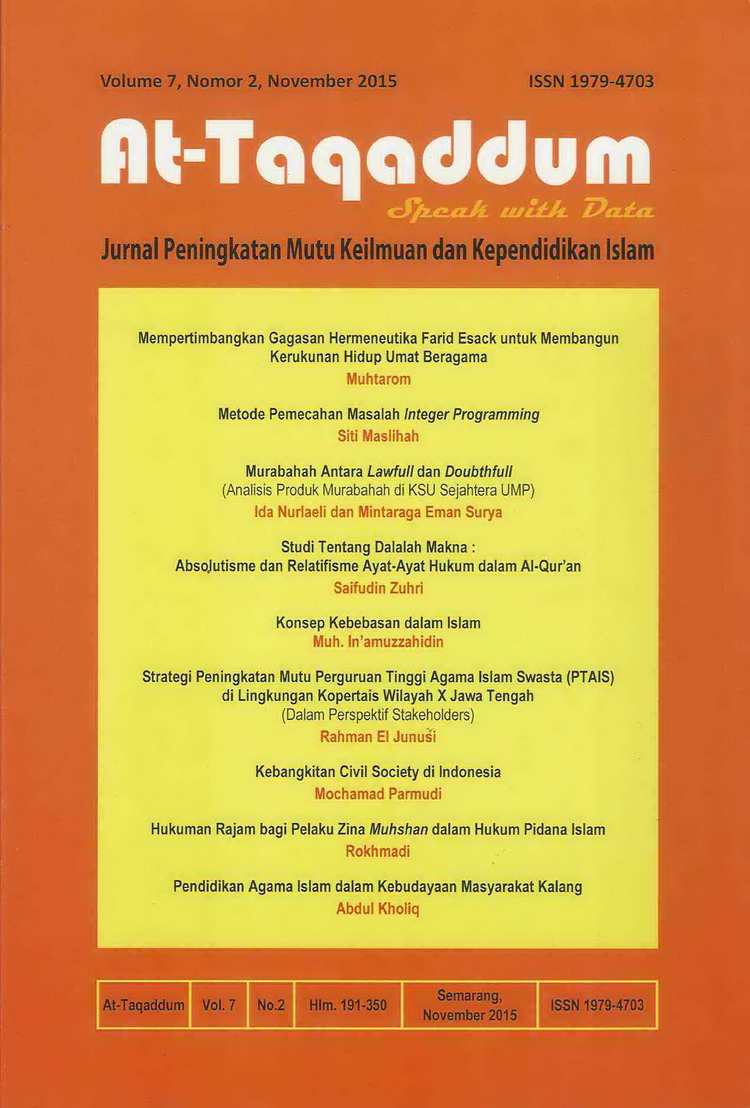STUDI TENTANG DALALAH MAKNA : Absolutisme dan Relatifisme Ayat-Ayat Hukum dalam Al-Qur’an
DOI:
https://doi.org/10.21580/at.v7i2.1205Keywords:
al-dalalah, qat’i, ijtihad, al-Qur’anAbstract
Al-Qur’an is a hammalat li al-wujuh, so that from meaning searching aspect famous with an expression, someone doesn’t called mufasir except if he can to give various interpretation toward every verses of al-Qur’an. That is way from the expert of usul and fuqaha inclined give interpret to the al-Qur’an as Allah’s word in meaning lafzi word, because their purpose is for instinbat al ahkam. With hammalat li al wujuh sure will give the different of law comprehension, even may be happen contradiction in interpretation a verses of ahkam. In term of usul fiqh absolute and relative oftenconnected with their technical term about qat’i and zanni in realize verses of dalalah. Verses that showing absolute is qat’i and which showing relative is zanni. Relativism is concepts which declare that a life value is relative, different according to the conditions development, culture, etc. Conversely absolutism looks at that life a value doesn’t change, not relative, but absolute although conditions, culture, and the other experience change. Especially in law side, appear the questions whether law verses in al-Qur’an there has absolute and don’t know law development existence causes period development.
It is time for the experts doesn’t base on analyses harfiyah-tekstual on law verses which has qat’i. should always understood that ahkam verses thinking building fundamental harmony, humanity universals or social justice. Individual interpretation offer towards provision both for qat'i also peace that can to guarantee humanity harmony in the eyes of Islam valid. Approach barer, easy to dialogue and contextual towards verses ahkam with integration in society life make easy to popularizing fiqh. on the basis of this so law consistence that appointed based on verses ahkam may not quit of mawasid al-hukm li jalbi al-masalih wa dar’i al-mafasid.Downloads
Downloads
Published
How to Cite
Issue
Section
License
The copyright of the received article shall be assigned to the journal as the publisher of the journal. The intended copyright includes the right to publish the article in various forms (including reprints). The journal maintains the publishing rights to the published articles. Therefore, the author must submit a statement of the Copyright Transfer Agreement.*)

This work is licensed under a Creative Commons Attribution-ShareAlike 4.0 International License.
In line with the license, authors and third parties (readers, researchers, and others) are allowed to share and adapt the material. In addition, the material must be given appropriate credit, provided with a link to the license, and indicated if changes were made. If authors remix, transform or build upon the material, authors must distribute their contributions under the same license as the original.
________
*) Authors whose articles are accepted for publication will receive confirmation via email and send a Copyright Transfer Agreement.











